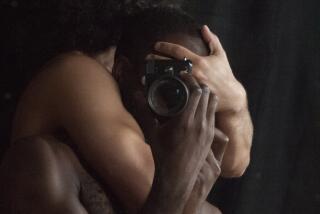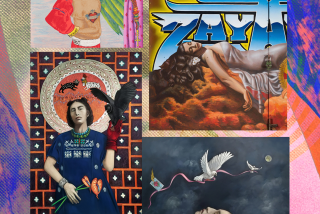Walker’s rich palette: black and white
You don’t have to be queer to be a queer artist.
Take Kara Walker. At the UCLA Hammer Museum, her beautifully installed traveling exhibition of drawings, video animations and black-paper-silhouette murals is nothing if not queer. Walker’s work gains its captivating power from a cheerfully ferocious deviation from the norms that typically characterize discussion of African American life.
Her subject is black experience in a proud nation whose prosperity and might were substantially built on the degrading legacy of black slavery. This historical truth is not news, but neither is the gruesome story confined to the remote past.
The refined, formal elegance of the artist’s debonair design sense is put to the rudest ends, and an impure vision of racial and gender identity arises. No one escapes unscathed.
The first room of “Kara Walker: My Complement, My Enemy, My Oppressor, My Love” features a 50-foot-wide, 1994 diorama in which silhouette figures attached to the curved wall are slightly larger than life-size. The title is florid: “Gone, An Historical Romance of a Civil War as It Occurred Between the Dusky Thighs of One Young Negress and Her Heart.” A literary mash-up of Margaret Mitchell’s 1936 “Gone With the Wind” and Thomas Dixon’s 1905 “The Clansman: An Historical Romance of the Ku Klux Klan,” the diorama’s scenes of courtship, lust, whimsy and depravity are depicted with the grandeur of an epic and the buffoonery of a minstrel show.
The cinematic allusions are apt. (“The Clansman” was source material for D.W. Griffith’s “The Birth of a Nation.”) The diorama puts you in the center of a curved space, as if the sweet and horrifying imagery on the surrounding walls was a projection of your own anguished mind.
Queer art arose in the 1980s. It was born of a profound recognition of the ways people project fantasies onto invisible sectors of society, and it was accelerated by the death toll of the AIDS epidemic amid gross government indifference. Walker’s art queers the racial discourse.
She goes for the subliminal, just below a sensory threshold that divides the world into comfortable dualities of good and evil, purity and vice, conqueror and casualty. Victimization and desire are represented as externally imposed and internally constructed, while freedom is represented as a contested fantasy that fosters inspiration and calamity in roughly equal measure.
Despite the materials of cut paper on gallery walls, Walker’s spiritual and emotional world is neither black nor white. Instead, panoplies of gray flood the scene.
Mixing it up
The survey begins in 1993 with “You Do,” a paper silhouette affixed to canvas in which a stylishly drawn, stereotypically primitive African female toys with a small voodoo doll -- “Do do that voodoo that you do so well” -- while the figure’s mirror image does the same with a top-hatted dandy. Stylistically, Jim Crow meets Cole Porter, while thematically, King Cotton meets the Cotton Club.
It culminates in a devastating 2005 animated film, shown that year in a different format at L.A.’s Gallery at REDCAT. The brutality of the slave era’s middle passage mixes with the “Zip-a-Dee-Doo-Dah” of Disney’s “Song of the South.”
Like Matisse’s late paper cutouts, Walker’s silhouettes and related animations are variations on drawings. Substituting a blade for a pencil, she gleefully runs with scissors.
The show is further enriched by a large selection of watercolors, preparatory studies and notebook sketches. Partly they chronicle the different ways in which the artist tries to complicate what could be a narrow and restricting medium.
Sometimes she roughs up the surface on which the silhouette is pressed. Elsewhere, overhead projectors cast abstract light patterns on walls affixed with silhouettes.
One work is a cyclorama -- a 360-degree walk-in image, recalling the format of the Atlanta Cyclorama, housing an epic painting that chronicles a decisive Civil War battle. (The New York-based artist, born in 1969 in Stockton, Calif., spent her teen years living in Atlanta.) Another gallery employs cut black paper on walls painted black.
A 1994 ink drawing, made around the time Walker graduated with a master’s degree in painting from Rhode Island School of Design, shows two black women wrestling. Titled “The Oppressor/Oppressed Paradigm,” the pair is deftly rendered so that they seem to merge into a single female form -- a woman who pins herself to the ground, immobilized from outside and self-defeated from within.
The drawing is pivotal. Rather than helplessly wail, “Look what you did to me,” or defiantly proclaim, “I will not be abused,” Walker’s cacophonous art marvels at what we do to one another, while staring open-mouthed at the ways we abuse ourselves.
Race relations, central to the American story, are key to this human saga. The well-mannered technique of 18th century cut-paper silhouettes is an inspired choice of contradictory artistic medium to limn the brazen contours of this Enlightenment-era narrative.
Remember Pittman
The otherwise satisfying show does suffer one prominent curatorial failing. It is the fault of the organizing museums, not the artist.
Introductory text at the Hammer’s entry and in the accompanying brochure announces, “At her New York debut at the Drawing Center in 1994, Kara Walker unveiled a daring reinvention of image-making in which she incorporated the genteel 18th century medium of cut-paper silhouettes into her paintings.” In reality, this “daring reinvention” had already been underway for nearly a decade -- in Lari Pittman’s paintings.
The Los Angeles artist began incorporating pre-Victorian silhouette motifs into his queer-themed work as early as 1985, and by 1990 they were prominent. Graduate students everywhere went to bed with the catalog of the Museum of Contemporary Art’s landmark 1992 show “Helter Skelter” -- which featured Pittman’s work -- tucked under their pillows.
His silhouette-festooned paintings were among the few works that critically survived the otherwise disastrous 1993 Whitney Biennial, which focused on issues of class, race, gender and sexuality.
In 1996, L.A. critic Michael Duncan, reviewing the painter’s midcareer retrospective at the Los Angeles County Museum of Art for Art in America magazine, got right to the point.
“Pittman’s embellishment of the silhouettes with surprising sexual features -- such as erections and ejaculations -- fascinatingly prefigures similar imagery in the recent work of Kara Walker,” Duncan wrote.
Check the show’s 400-page catalog. Although everyone from Romare Bearden to Daniel Buren is cited, you won’t find any mention of Pittman’s art, despite its ubiquity when Walker’s career was launched. It’s sort of like mounting a Rachel Whiteread retrospective with no mention of Bruce Nauman’s sculpture.
I bring up this elision not because -- full disclosure -- Pittman is a friend but because it is emblematic of the way Los Angeles artists regularly disappear from American art history, which is largely written from an East Coast perspective. Minneapolis’ Walker Art Center, which organized the Hammer’s show, is a very fine museum, but artistically it’s also commonly regarded as an out-of-town Manhattan franchise.
To see an L.A. museum repeat the erasure on its own walls makes your heart sink. To see it at a museum at UCLA, where Pittman has taught for 15 years, makes your head spin. Together it’s a queer example of L.A.’s art world pinning itself to the ground, immobilized from outside and self-defeated from within.
--
--
Kara Walker
Where: UCLA Hammer Museum, 10899 Wilshire Blvd., Westwood
When: 11 a.m. to 7 p.m. Tuesdays, Wednesdays, Fridays, Saturdays; 11 a.m. to 9 p.m. Thursdays; 11 a.m. to 5 p.m. Sundays
Ends: June 8
Price: $5
Contact: (310) 443-7000
More to Read
The biggest entertainment stories
Get our big stories about Hollywood, film, television, music, arts, culture and more right in your inbox as soon as they publish.
You may occasionally receive promotional content from the Los Angeles Times.











